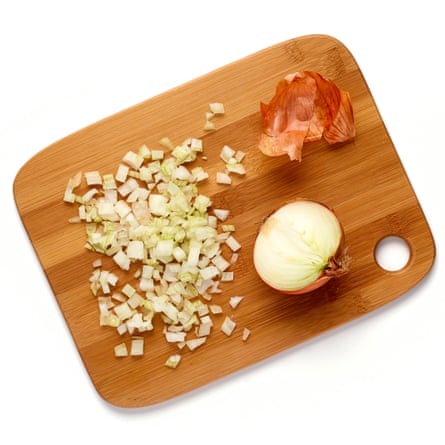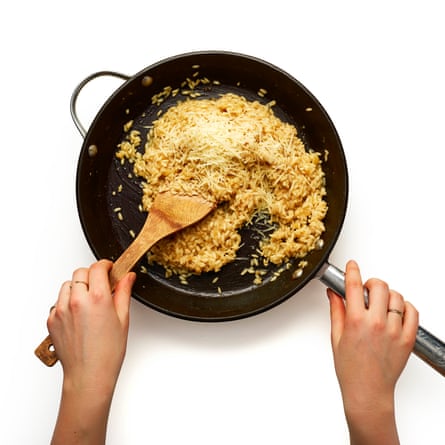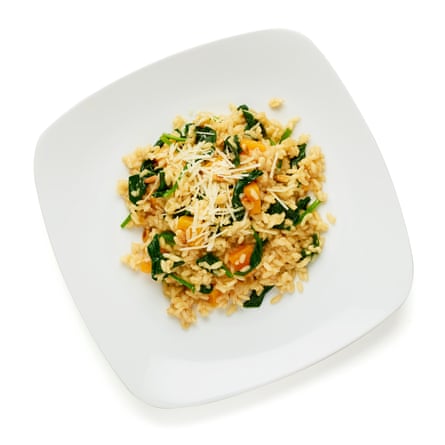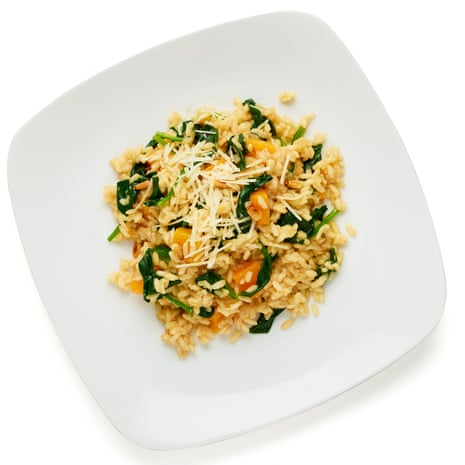I’m going to let you in on a little secret: despite what every nonna and Italian cookbook will tell you, you don’t need to chain yourself to the hob to make a decent risotto. The method below, which involves a mere two minutes of stirring, comes from a fourth-generation rice grower from the Veneto. And if it’s good enough for him …
Prep 5 min
Cook 35 min
Serves 2
125ml white wine
550ml stock
3 tbsp butter
½ onion, peeled and chopped
200g risotto rice, carnaroli or vialone nano ideally, though arborio will do
25g parmesan, grated
1 Make the broth
Bring the wine and 400ml of the stock to a simmer (chicken or vegetable are the most versatile, but ham, fish or beef may work better, depending on your choice of ingredients: if you’re using a stock pot or cube, which can be salty, taste and dilute as necessary before use). Red wine is sometimes used for risottos featuring beef or sausages.
2 Starting off
Over a medium-low heat, melt two tablespoons of the butter in a wide, shallow pan for which you have a lid (a wide pan means that more of the rice will come into contact with the stock, so it will cook more evenly). If you’re making a seafood risotto, or would simply prefer to keep the dish dairy-free, use extra-virgin olive oil instead.
3 Sweat the veg
Add the onion to the pan and cook, stirring, until it’s soft and golden; make sure it doesn’t brown. Depending on what kind of risotto you’re making, once the onion has begun to soften, you could also chuck in finely chopped garlic, carrot, celery or pancetta, but leave any fresh herbs and other delicate ingredients until the end.

4 Add the rice
Turn up the heat slightly and tip in the rice. Stir to coat with the butter and fry until it’s hot to the touch, without letting it colour. Use arborio rice, if that’s all you can find, but carnaroli and vialone nano are starchier, more robust varieties that are harder to overcook, so will produce a creamier result.

5 Stop stirring
Pour in the hot stock and wine, and bring to a simmer. Cover the pan and leave to cook, undisturbed, for 15 minutes – a good time for the cook to pour a glass of wine and put your feet up: once you’ve warmed the remaining stock, cut the rest of the butter into pieces and grated the cheese, that is.
6 Add more liquid
After 15 minutes, the rice should be almost tender, with just a hint of bite, and have absorbed all the cooking liquid. Add the butter (or oil) and the remaining 150ml stock to the pan, then stir for a couple of minutes, until the risotto is creamy but the consistency is still fairly loose.
7 Add the cheese
Stir in the grated parmesan (or pecorino, or any hard, dry cheese, or leave it out altogether, if you prefer, or if you’re making a seafood risotto). Either way, turn off the heat, cover the pan again and leave to sit for two minutes, then season to taste (a touch of nutmeg works well) and serve.

8 Finishing touches
This basic risotto is delicious on its own, or with cooked veg stirred through it (I had mine with wilted spinach and baked squash), but it’s easy to adapt. A classic Milanese risotto, say, is made with beef stock and a good pinch of saffron (add it to the final 150ml stock as it warms) and served alongside osso buco.

9 Variations
Mushroom risotto can be made along the same lines, with meat or vegetable stock and the soaking liquid from dried porcini. As can, in just a few weeks’ time, asparagus risotto made with vegetable or chicken stock and a glug of asparagus cooking water. Note that fragile ingredients such as asparagus or seafood are best cooked separately and stirred into the risotto just before serving.

Comments (…)
Sign in or create your Guardian account to join the discussion